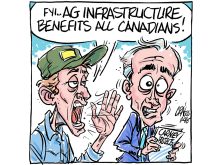WHEN federal finance minister Ralph Goodale announced in mid-October that he had made a mistake in calculating the 2003-04 budgetary surplus – it was $9.1 billion instead of $1.9 billion as promised – the opposition predictably pounced.
Goodale bragged that the extra $7 billion was used to pay down the federal debt, getting it close to $500 billion. With a $60 billion pay-down since 1998, annual debt servicing charges are down $3 billion, making more money available for programs.
Not good enough.
New Democrats accused the Liberals of deliberately low-balling the surplus to avoid investing in new programs.
Read Also

Downturn in grain farm economics threatens to be long term
We might look back at this fall as the turning point in grain farm economics — the point where making money became really difficult.
Bloc Québecois MPs saw it as another reason to separate because it showed Ottawa is benefiting from a “fiscal imbalance” that sees too many tax dollars going to the centre and too few to the provinces.
Conservative Party critics mocked the government’s inability to count but also said government finances should be more transparent so Canadians can decide how surpluses should be spent.
Finance critic Monte Solberg led the charge in suggesting tax cuts or more spending might have been Canadians’ preferred choice.
“Low income and middle income Canadians would love to have some of that money to spend on extravagances like groceries, or what about properly equipping our military?”
There was not a single Conservative word in praise of the reduction in public debt.
That is amazing. The Conservatives, through their ancestor Reform and Canadian Alliance parties, were debt busters.
No more, it seems.
A bit of history is in order.
Despite the best efforts of apologists for Progressive Conservative prime minister Brian Mulroney to paint his government as the beginning of the fight against the deficit (Globe and Mail editorial writers, come on down), the 1984-93 Tory government more than doubled Canada’s national debt, adding more than $200 billion and leaving the country with a $42 billion deficit in the last year.
It was one of the reasons the Reform party displaced the Conservatives in fiscally conservative Western Canada in 1993.
During his tenure as Reform leader, Preston Manning can be credited with two big contributions to the national political debate – convincing the Liberals to adopt a less wishy-washy policy on Quebec and convincing the nation that the run-away debt was an issue that had to be tackled.
When Manning first rode out of the West on his fundamentalist horse, the federal government was spending close to 40 cents of every tax dollar raised on debt servicing.
His arguments against that allowed the Liberals and Paul Martin to get away with the 1995 budget that was the most brutal reduction in government spending and services in the history of the welfare state.
Canadians accustomed to Manning’s sermon on the debt were ready for the bitter medicine, if not the primary preacher.
The new Conservatives appear to have lost that debt-cutting zeal, even though the debt is still gargantuan and more than $30 billion annually goes to debt servicing.
Where did the debt theology go? Probably to the same remote political island where Stephen Harper has parked his once-vehement opposition to the Charlottetown Accord attempt to design a federal “asymmetrical” system that could give special powers to a province like, oh say, Quebec.
















